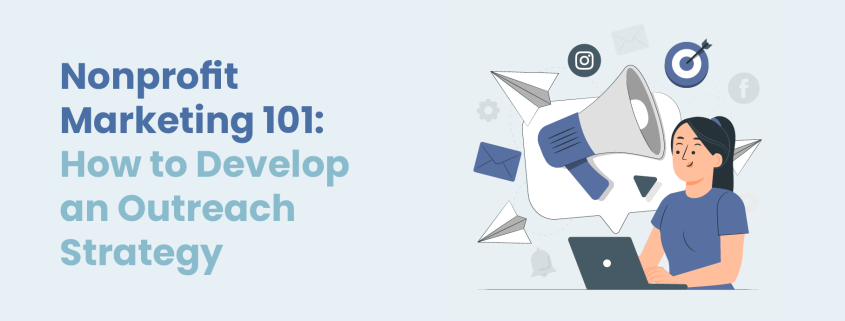Nonprofit Marketing 101: Developing an Outreach Strategy
The importance of spreading awareness cannot be understated for nonprofits. After all, the more people know about your cause, the more likely you are to receive funding that keeps your programs running. As such, almost all nonprofits conduct some level of marketing.
To grow your organization, secure reliable revenue, and generate widespread support for your cause, it’s time to turn your casual outreach efforts into a formal marketing strategy.
In this guide, we’ll walk through nonprofit marketing essentials, including:
- What is Nonprofit Marketing?
- Types of Nonprofit Marketing
- How to Develop a Nonprofit Marketing Plan
- Top Nonprofit Marketing Strategies
Your nonprofit marketing strategy will depend on your unique mission, community, and resources. However, there are general time-tested strategies that most nonprofits can benefit from that we’ll explore in this guide.
But first, let’s explain exactly what nonprofit marketing is.
What is Nonprofit Marketing?
Nonprofit marketing consists of all of the activities charitable organizations take to promote their mission, solicit donations, connect with beneficiaries, and sell products or services. For instance, a social media post promoting new product offerings, an educational blog article, and a digital newsletter email all fit under the umbrella of nonprofit marketing.
Marketing is a broad topic, and no one guide can touch on every aspect of it. That’s why many nonprofits turn to marketing consultants, have dedicated marketing teams, and stay up to date with the latest nonprofit marketing trends.
In this guide, we’ll provide a general overview of how to develop a structured marketing plan for nonprofits seeking to formalize their outreach approach.
Types of Nonprofit Marketing
For the most part, all types of marketing can be sorted into one of two categories: outbound and inbound. A comprehensive nonprofit marketing strategy involves both types of outreach. Here’s an overview of each approach.
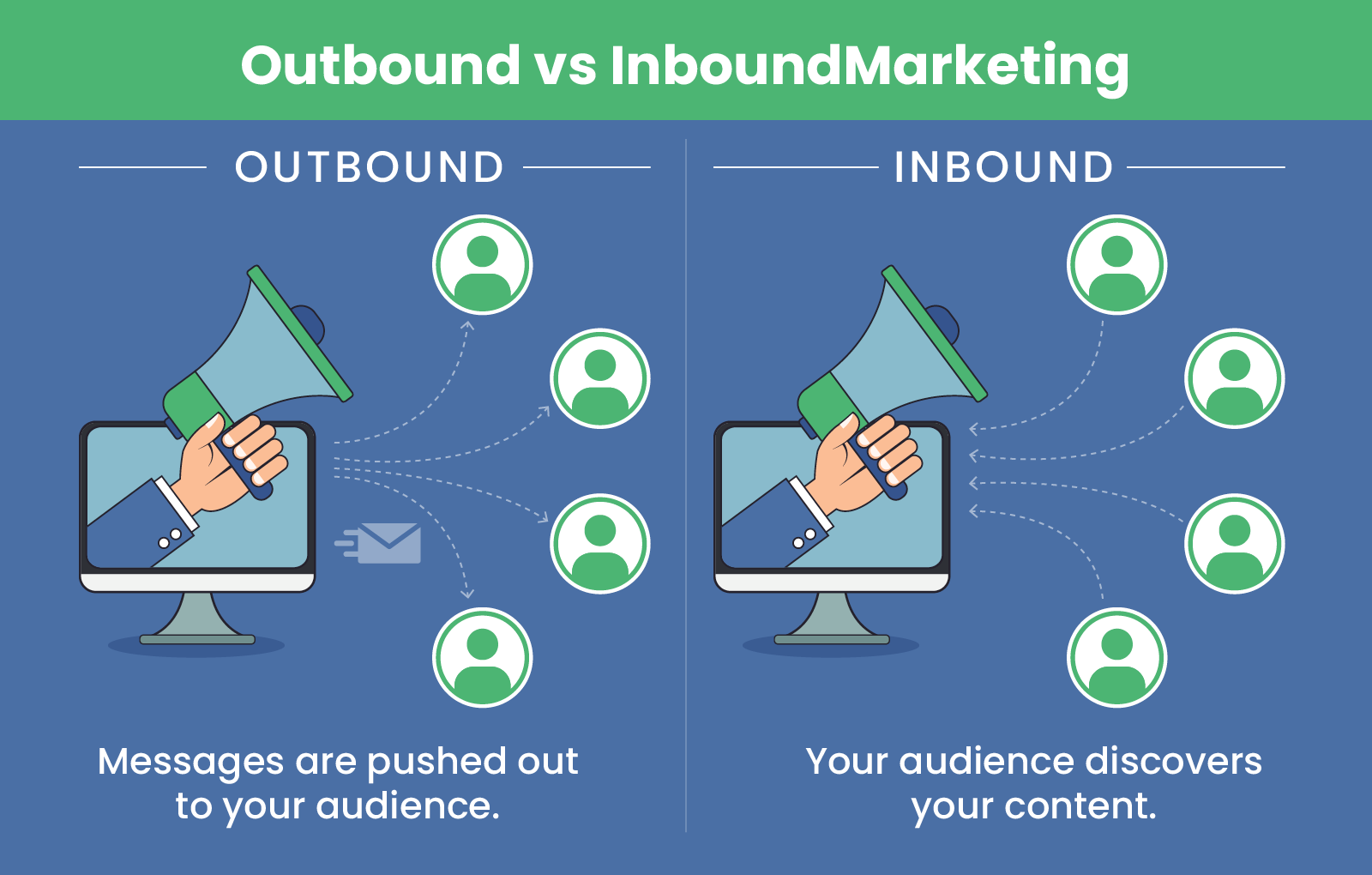
Outbound
Outbound marketing consists of messages that your nonprofit pushes out to your audience. Usually, this is done by performing outreach on external platforms to get your organization discovered by a wide audience.
A few examples of outbound marketing include:
- Social media ads
- Radio ads
- TV commercials
- Newspaper ads
- Flyers
- Search engine ads
In general, outbound marketing is thought of as advertising and usually requires your nonprofit to pay the platform hosting your ads. These messages are meant to be shown to individuals engaging with other content, such as a prospective supporter scrolling through social media, and intrigue them into checking out your nonprofit.
Inbound
Inbound marketing consists of content your nonprofit creates for the purpose of engaging individuals interested in your cause. This content is usually hosted by your nonprofit, such as on your website, and prospective supporters discover it through their own research.
For example, an individual interested in research on deforestation might use a search engine to find a nonprofit’s study on environmental degradation, which would then cause them to engage further with the nonprofit and potentially make a conversion.
Examples of inbound marketing include:
- Blog posts
- Organic social media posts
- Search engine optimization (SEO)
Email marketing is also sometimes considered inbound marketing. While these messages are pushed out to your audience, they are being sent to individuals who have in some way self-selected to engage with your nonprofit, whether by donating, volunteering, or signing up for your newsletter.
Both outbound and inbound marketing are valuable approaches to marketing. Through inbound marketing, high-value leads essentially recruit themselves to your cause, whereas outbound marketing exposes your content to prospective supporters who may not have otherwise found your cause.
They can also work in tandem. For example, someone might see an ad for your nonprofit on Facebook, which inspires them to do their own research on your target issue, leading them to one of your educational blog posts. As such, don’t think of outbound and inbound marketing as an either/or situation, but rather two sides of one cohesive marketing strategy.
How to Develop a Nonprofit Marketing Plan
1. Perform a SWOT analysis
Before creating a marketing plan, you should assess your nonprofit’s ability to execute a successful marketing campaign. While marketing campaigns can (and should!) drive support to your nonprofit, failed efforts can eat into your budget at best and hurt your nonprofit’s reputation at worst.
As such, your first step to pivoting to a structured marketing strategy should be to perform a SWOT analysis.
SWOT stands for strengths, weaknesses, opportunities, and threats. Organizations of all types perform SWOT analysis to predict how marketing strategies, product launches, new service offerings, and even entirely new businesses will perform. As such, SWOT analyses can be particularly effective for nonprofits selling products but can be used for fundraising campaigns, as well.
Let’s walk through the core components of a SWOT analysis:
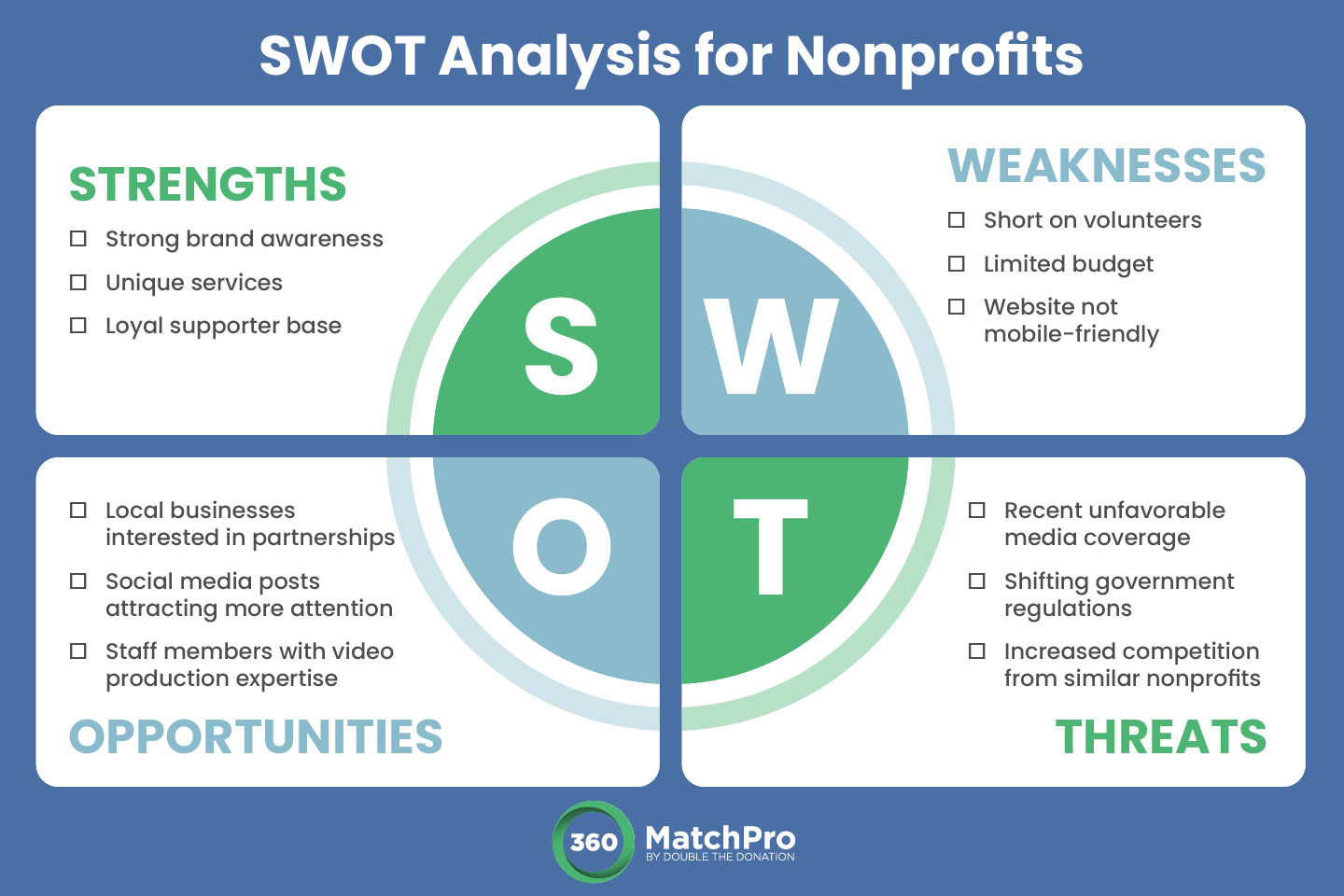
- Strengths. What does your nonprofit currently have going for it that would translate into positive marketing results? This includes resources, like reliable marketing tools, knowledgeable staff, and a loyal community.
- Weaknesses. What does your nonprofit currently lack that might negatively impact a marketing campaign? This often includes budgetary constraints and, for nonprofits just getting started with marketing, a lack of awareness and brand recognition.
- Opportunities. Assess the current landscape of your community, marketing trends, and sector to identify opportunities that could significantly boost your marketing efforts. For example, your target issue might have recently garnered a lot of media attention, or you might be on the cusp of securing a corporate partnership.
- Threats. In the same assessment of current opportunities, consider whether there are any expected upcoming threats. For example, if your nonprofit plans to expand to TikTok, you might have concerns about the fate of the platform given recent legislation.
SWOTs provide a baseline understanding of whether a potential marketing campaign is likely to succeed. But remember that SWOTs can sometimes provide conflicting data that you’ll need to take a critical eye to. For example, you might identify that the year-end giving season is a prime opportunity for fundraising due to elevated levels of giving but also that there is the threat of increased competition.
Use your SWOT analysis as a tool to clarify what resources your nonprofit has at its disposal, make plans for predicted marketing challenges and opportunities, and determine if now is the right time to launch a marketing campaign at all.
2. Establish your value proposition.
A value proposition is a one-sentence explanation of why someone should buy your product or service, making it a useful guide for constructing a marketing campaign. This definition holds true for nonprofits that sell products, services, and programs, as well as nonprofits that request donations.
While supporters may not receive anything in exchange for a donation, you should still construct a value proposition that explains what supporters get out of donating to your nonprofit. To help you create a value proposition, let’s first walk through its three core elements:
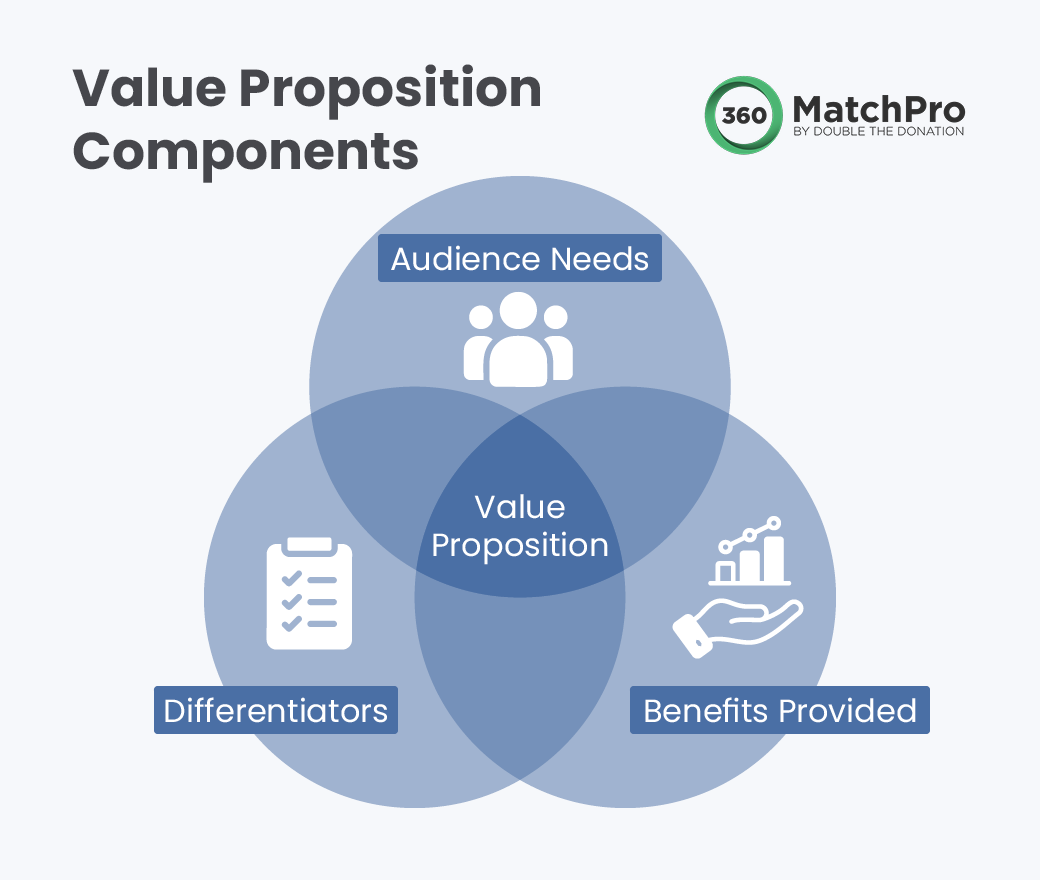
- Audience needs. Consider your target audience and what they are looking for in a potential product offering. For example, the Nonprofit Leadership Alliance (NLA) targets nonprofit professionals in need of training.
- Differentiators. What is unique about your products or services? Assess competing organizations and pinpoint how your offerings differ and offer additional value.
- Benefits provided. What are the core benefits your products or services provide? Go beyond what the product or service itself does. For example, the NLA might state that they provide the benefit of expert training and networking opportunities rather than just training resources.
Now, let’s construct a value proposition for a nonprofit that does not have a product offering. For example, the hypothetical nonprofit Cat Rescue Club specializes in adoption services for cats. Its value proposition would have the following elements:
- Audience needs: Cat lovers who want to support animals in need.
- Differentiators: Cat Rescue Club specializes in the unique needs of cats, which are sometimes overlooked by general animal shelters.
- Benefits provided: Individuals who donate will feel good about their contribution to a cause that helps the animals they love.
Put together, the value proposition is: Cat lovers who donate to Cat Rescue Club can rest assured that they are making a tangible impact in the lives of feline friends in need.
3. Determine your audience.
Most nonprofits want as large an audience as possible, and many organizations might state that their cause is for everyone. However, “everyone” is not an audience your marketing campaign can feasibly target.
Your nonprofit will find more success by tailoring its messaging strategy to a specific audience. Nonprofits often have several audiences, but most of their campaigns should target a specific subset of that audience. For example, a few general audience segments many nonprofits have include:
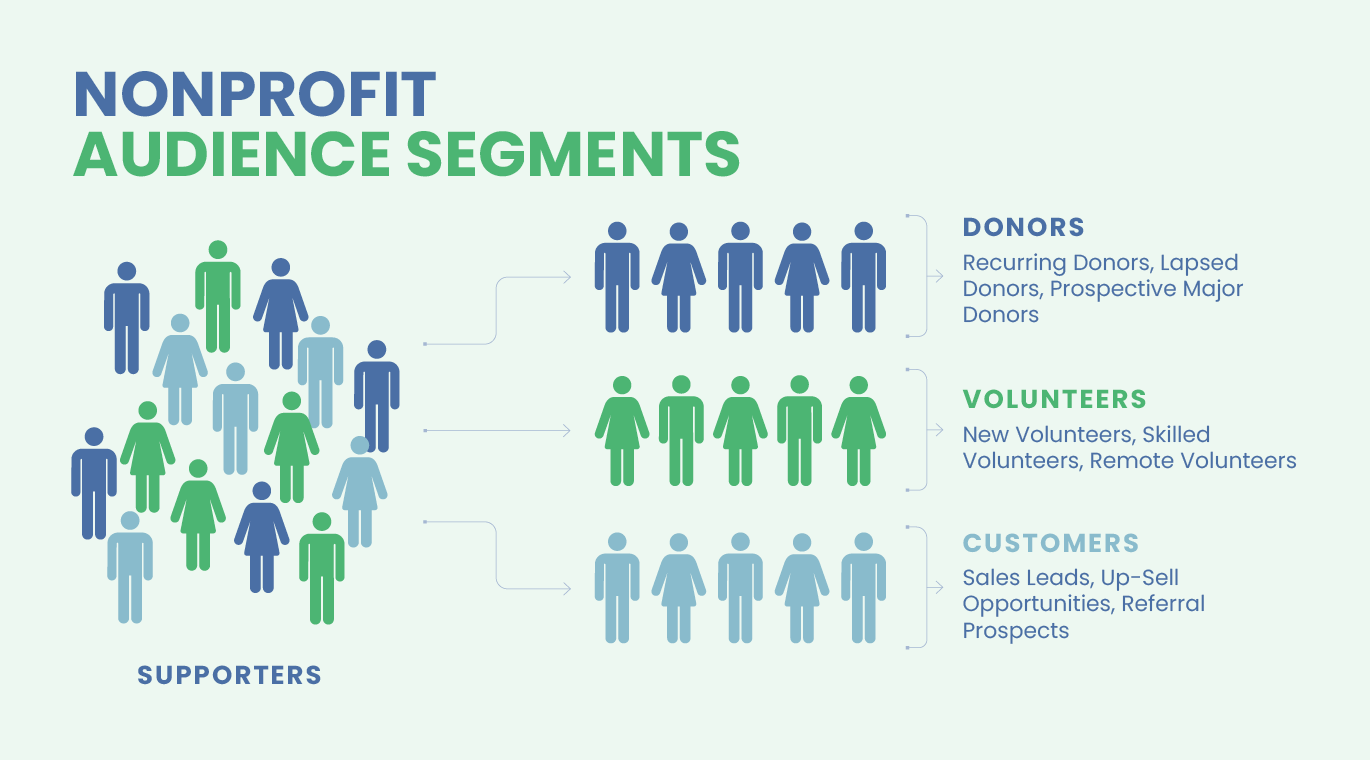
- Donors can be further divided into recurring donors, lapsed donors, prospective major donors, new donors, one-time donors, planned donors, and other groupings based on their level and type of support.
- Volunteers can be grouped into new volunteers, skilled volunteers, remote volunteers, corporate volunteers, volunteer grant prospects, and other segments based on the type of support provided.
- Customers include sales leads, upsell opportunities, referral prospects, loyal customers, unsatisfied customers, and any other groups who buy your nonprofit’s products and services.
You can look at each of these groups and divide them further still based on relevant demographic information, such as their age, income, location, and so on. For example, your nonprofit might hold a volunteer drive aimed at college students at nearby campuses and a fundraising campaign focused on encouraging elderly donors to commit to planned gifts.
4. Set marketing goals.
Every marketing plan should have specific, measurable goals. Campaigns have many moving parts, and a concrete goal can keep your team organized, motivated, and focused.
However, an overarching goal may feel too nebulous to your team. For example, you might have a goal of increasing annual donations by 25%, but how does that translate into individual actions like decorating an event space? Keep your expectations clear and provide guidance by breaking your goals down into three levels:
- Mission. Your mission is your nonprofit’s overall objective. Usually, this relates to your programs and initiatives, such as providing free school supplies to underserved communities, restoring local rivers’ ecosystems, or destigmatizing mental health conditions.
- Goals. Goals help your nonprofit achieve its mission, and every marketing campaign should have one primary goal. For example, you may want to increase funding to ensure your programs can continue operating. As such, you might have a marketing campaign with a goal to increase Giving Tuesday donations by 15% over the prior year.
- Objectives. Every marketing campaign is made up of individual tasks, and completing these objectives helps you achieve your goal. For instance, in the Giving Tuesday campaign, an objective might be to create materials for a Giving Tuesday marketing blast.
Create a fundraising calendar to keep track of specific marketing campaigns’ activities, deadlines, and personnel. You can also create calendars for specific activities, such as a social media calendar that documents when content will go live.
5. Create your message.
Your marketing materials should convey a unified message that drives supporters to convert. However, before jumping into writing, consider where each piece of your marketing materials will fit in the sales funnel.
A sales funnel—sometimes called a donor funnel by nonprofits without product offerings—is a tool that helps marketers visualize how close prospective customers are to converting. You should create marketing materials that help guide supporters through each step of the sales funnel.
While various sales funnel models vary in how many stages there are and what those stages are called, most models have the following steps:

- Awareness. Before converting, individuals need to become aware of your nonprofit. For nonprofits with sales offerings, this means learning about the types of products and services you provide. For nonprofits seeking donations, this means becoming aware of your cause. To attract these customers and supporters, your nonprofit should create general educational content that provides a basic overview of your services or mission.
- Interest. Individuals who are interested in your offerings will continue their research. Educational materials are still useful at this stage, but content should provide deeper insights, be more specialized, or begin to make calls to action to convert.
- Decision. Before making a purchase, many individuals research multiple vendors to determine which organization they want to buy from. For nonprofits, this might mean deciding whether to donate to your nonprofit or another organization with a similar mission. Be sure your marketing materials differentiate your nonprofit and explain what makes your products or initiatives unique.
- Action. After completing their research, individuals will decide what organization to support. You can drive action through calls to action, such as donation appeals and donate buttons.
- Advocate. A few passionate individuals may go on to recommend your nonprofit to friends and family after donating or making a purchase. Be sure to have an informative products or programs page that these supporters can share.
The sales funnel is called a funnel because it is expected that individuals will drop out at various points until those who convert make it all the way to the end. As such, individuals bouncing off of your marketing materials at various stages in the funnel is normal. However, if you see a significant drop-off at any point, it may be worth reconsidering your marketing materials aimed at that stage.
6. Track results.
As your marketing campaign progresses, keep track of various metrics related to your goals with your nonprofit marketing tools. For instance, a few marketing-related key performance indicators include:
- Website traffic. How many people, in total, have visited your website? Monitor traffic for individual landing pages, especially high-value pages, like your donation form.
- Open rate. For email and text message campaigns, track the number of recipients who open your messages divided by the number of messages sent.
- Impressions. If your nonprofit engages in paid advertising, such as buying Google Ads, the platform will document the number of times your ad is shown to a user. This is your impression rate. For instance, if your ad is shown to 100 people, you have 100 impressions.
- Clickthrough rate. When you send an email with a link in it or create an ad, the number of people who click on the link or ad makes up your clickthrough rate. For example, let’s say you have a Facebook ad with 100 impressions and 20 clicks. That means the ad was shown to 100 people and 20 of them clicked on it. Keep in mind that paid advertising platforms often charge by either the number of impressions or the number of clicks.
- Engagement. Every social media platform has its own engagement system, but most usually measure engagement in some form of likes, shares, and comments. Whatever the specific system, high engagement shows an active fan base and increases the chance your content will be promoted to other users.
- Bounce rate. Bounce rate can mean one of two things. First, when you send an email that fails to deliver, it “bounces” back to you. Second, visitors who click on your website and then quickly click away without taking any action “bounce” away from your site. Both of these metrics are a sign something is wrong and should be as low as possible.
- Conversions. Conversions measure how many individuals actually completed your campaign’s desired action. This might be supporters who donated, signed up to volunteer, shared an awareness message, or bought a product. As such, conversions are your campaign’s most important metric.
Based on your marketing strategy, you may also need to monitor other metrics. For example, if your campaign involves an event, you might record the number of attendees and audience retention rate.
To track this data, use reporting tools like email platforms, nonprofit event management software, CRMs, phone banking software, and website monitoring tools like Google Analytics.
Top Nonprofit Marketing Strategies
1. Email marketing
Email is a staple of nonprofit marketing due to its ability to convey a wide range of messages formally, promptly, and conveniently. A few ways to use email include:
- Regular newsletters
- Donation appeals
- Welcome messages
- Sales promotions
- Event invitations
- Fundraiser promotions
- Holiday greetings
- Thank-you messages
- Mission updates
Almost any marketing idea can be backed up by an email campaign. For assistance, you might email your subscribers to alert them about an upcoming crowdfunding campaign, or you might provide a report on how an advocacy event went.
2. Paid advertising
Be cautious about paid advertising as fundraising reports have found that increased spending does not necessarily equal improved results, meaning it’s possible to not make up your return on investment.
Fortunately, there are free and low cost options available to nonprofits, like the Google Ad Grant. The Google Ad Grant is a free program offered by Google that provides participating nonprofits $10,000 in advertising credits every month. This means nonprofits can create search results ads for high-value keywords for free!
Here’s an example of a Google Ad:
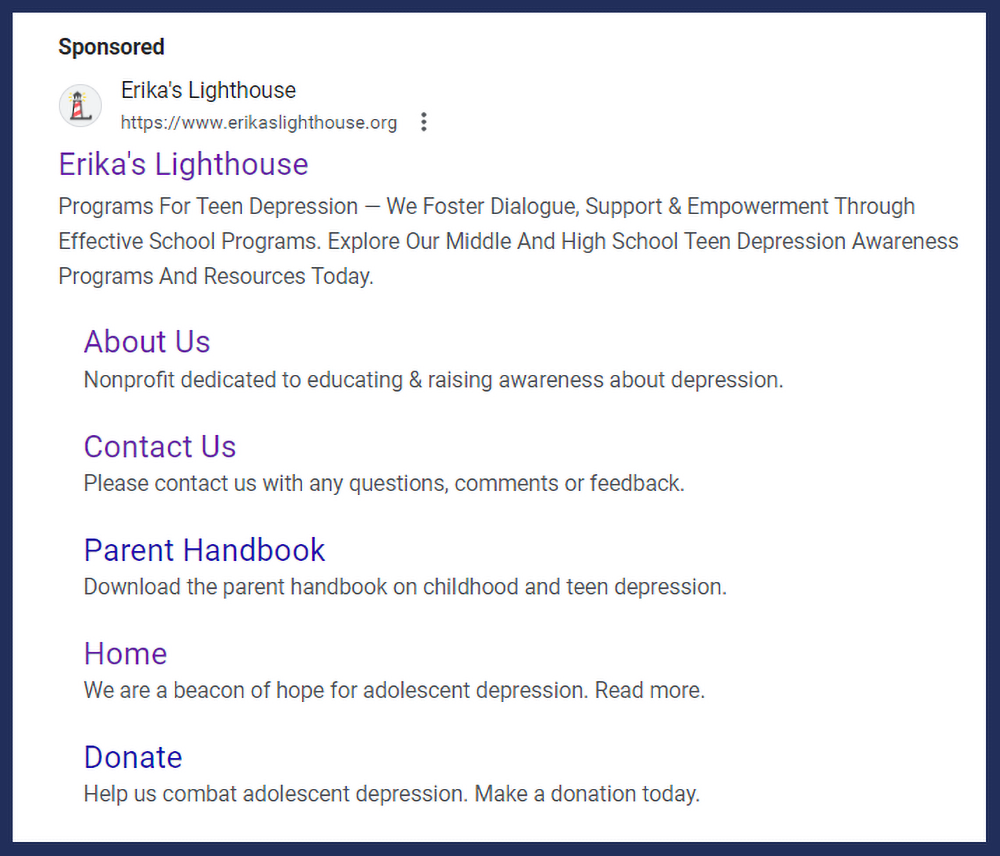
This ad shows off a strategy for making your Google ads more valuable: sitelinks. Rather than just one main link to your website, you can expand your ad to include multiple links that might entice viewers and take up more page space, increasing the chances of a user clicking on your ad.
Google actually encourages sitelinks. In fact, participating nonprofits are required to have at least two ads that use sitelinks. So consider not just the main page you want to promote via Google Ads but also what other high-value pages might entice visitors as well!
3. Direct mail marketing
Direct mail may be slower than email or social media, but it still has its place in marketing. Consider what types of messages are worth sending physical copies of, such as event invitations, informational pamphlets, and donation appeals.
Additionally, consider what else you might mail to supporters as part of a marketing campaign. For example, you might set up reward tiers for a crowdfunding campaign that include prizes like branded merchandise that you would then need to mail out. Or, you might remind supporters to make their end-of-the-year gift by sending them a calendar themed to your nonprofit for the upcoming year every December.
4. Content marketing
Previously, we discussed inbound marketing, which primarily involves content marketing. Now, let’s discuss how to make valuable content.
Your content can consist of anything related to your nonprofit. For most nonprofits, the majority of your content will likely be text-based blog posts. This is because when compared to visual mediums, content that is primarily text is easier and faster to produce. Plus, text gives you the space necessary to tell full-length stories, explain nuanced processes, and share thorough research reports.
To ensure your content reaches your target audience, enact search engine optimization (SEO) best practices. SEO makes your content more likely to get picked up by search engines, meaning it will be put in front of prospective supporters searching keywords related to your nonprofit.
When it comes to SEO, your nonprofit should prioritize creating high-quality, original content above all else. Search engines want to recommend expert, valuable content to their audiences and penalize content that tries to cheat the system with tactics like keyword stuffing.
Let’s take a look at the key elements of a piece of content related to SEO:
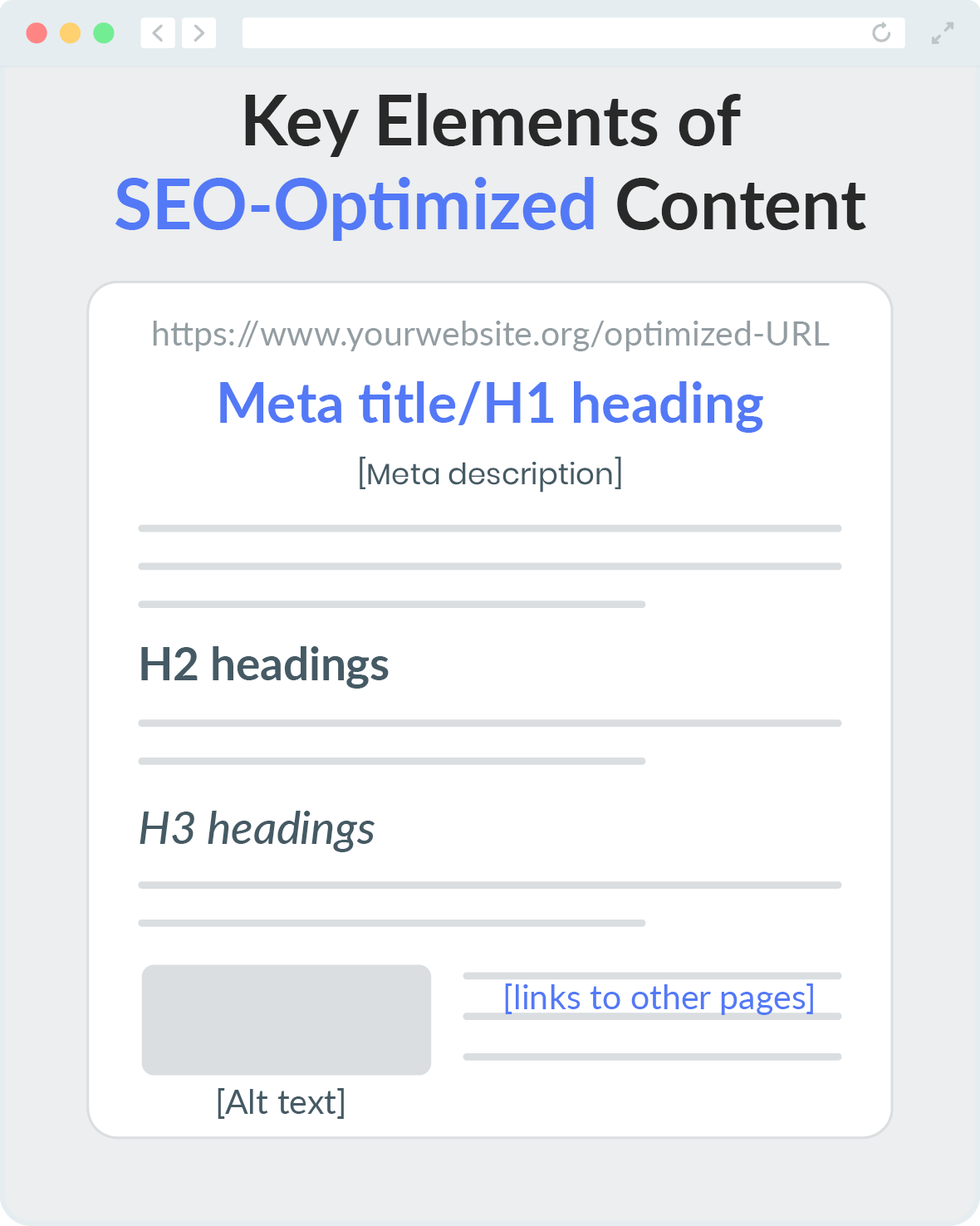
- URL. The URL for each page on your website should be relatively short and representative of the content. For example, the URL of this page is “https://360matchpro.com/nonprofit-marketing” and this guide is about marketing for nonprofits!
- Headings. All pages should have an H1, and long-form content should include multiple headers to break up text. Not only do headings make content more user-friendly, but they also signal to search engines what a page is about. Ensure your headings are natural, but where possible, include your keyword or a variation of it in each heading.
- Meta description. Your meta descriptions do not impact SEO performance. However, it is shown to prospective visitors scrolling through Google search results. Ensure each meta description accurately represents the page’s content to generate clicks and keep bounce rate low.
- Body text. For the most part, your body text should be natural and prioritize sharing your expertise with your audience. Aim to include your target keyword or variations of it a few times throughout the content where appropriate. The number of times a keyword should appear varies depending on the content’s length and subject matter. For instance, if your keyword is a specific medical term that has no alternatives, your keyword will likely appear many times without issue. However, if you plan to target a keyword like “environmental clean-ups in Boston,” one or two inclusions should likely suffice.
- Links. Link to external resources to increase your content’s credibility and usefulness. Also, add links to other content on your website when appropriate to encourage visitors to continue exploring your site. For instance, an animal shelter might have a guide on tips for keeping pets cool in the summer, and a section discussing feeding options might link to another article they wrote about helping pets maintain a healthy diet.
- Alt text. For images, add alternative text that describes the image. This makes the images accessible to individuals using screen readers. For videos, add closed captions or a transcript.
SEO marketing can be especially useful for nonprofits selling products. For these nonprofits, SEO content will create a reliable stream of leads, reducing the need for paid advertising. If this description fits your nonprofit, consider working with an SEO consultant who can shape, launch, and maintain your SEO strategy.
5. Video advertising
Video is currently one of the most popular marketing tools around, and for good reason. Marketing research shows that viewers who watch a video retain 95% of the information shown to them versus 10% retention when reading the same information in just text.
Compared to other marketing channels, video production is a more involved process, so be thoughtful about what messages will benefit from being made into videos. For instance, videos are commonly made to:
- Introduce an organization. Consider creating a video that provides a general overview of your nonprofit. A solid introduction video is highly reusable marketing collateral that can be added to your website’s home page, posted on social media, shared with new donors via email, or presented during events.
- Share a beneficiary story. Humans tend to be more persuaded by emotional appeals and stories than facts alone. Give your supporters a peak into your nonprofit’s work by interviewing beneficiaries and creating videos that showcase their stories.
- Explain a process. For nonprofits that tackle complex issues, such as environmental and medical organizations, explanatory videos can be helpful for spreading awareness about your target issue. These can be purely educational or PSAs that encourage supporters to take specific actions.
- Promote a specific fundraiser. Create videos to get your supporters excited about upcoming fundraisers. For example, you might create a video to promote an event or explain your ongoing crowdfunding campaign. Additionally, you might make a video that walks viewers through how to participate in a form of giving they might be unfamiliar with, like matching gifts.
While video may be a different format than your usual content, it should still follow your nonprofit’s brand guidelines. Consider creating a subsection of your style guide about video or a video-specific style cheat sheet. This might go into detail about how opening titles and credits should look, or you might provide just the basics about your organization’s colors, logo, and fonts.
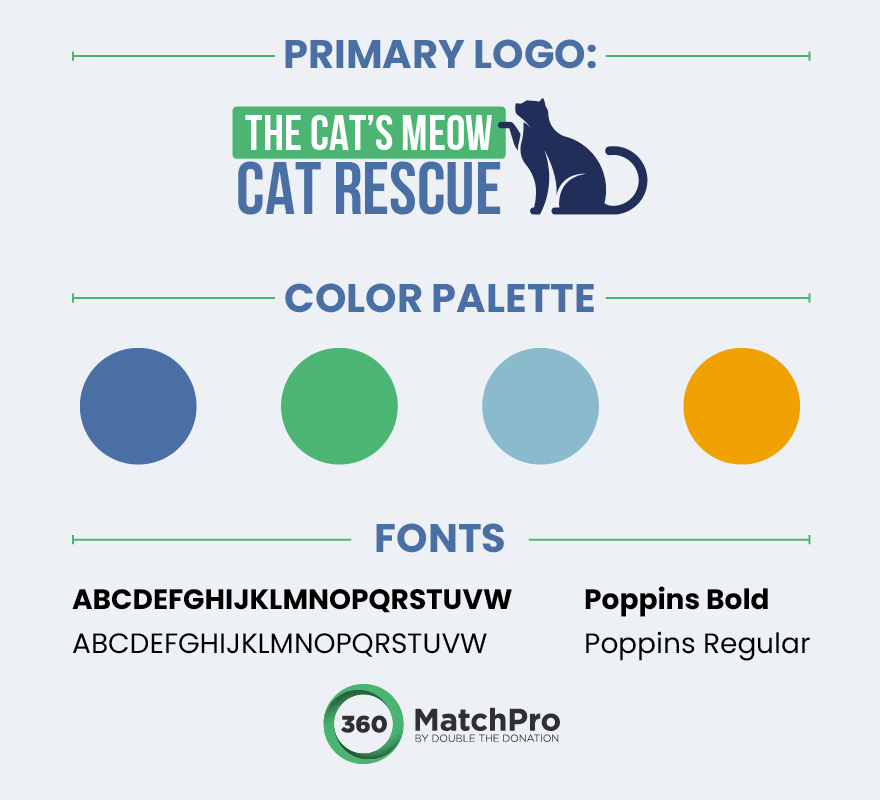
6. Influencer marketing
Influencers are internet micro-celebrities who command the attention of audiences of thousands on their platform of choice. This might be Instagram followers, TikTok viewers, or YouTube subscribers.
Today, many nonprofits are partnering with influencers to market their causes online. This could be as involved as an influencer running a fundraiser on your nonprofit’s behalf, or the influencer might make a few posts to encourage their audience to educate themselves on your target issue.
When it comes to partnering with influencers, consider two factors. The first is audience size. Influencers can be divided into a few categories based on their follower count, and for the most part, the bigger the audience, the more difficult getting in touch and arranging a partnership will be.
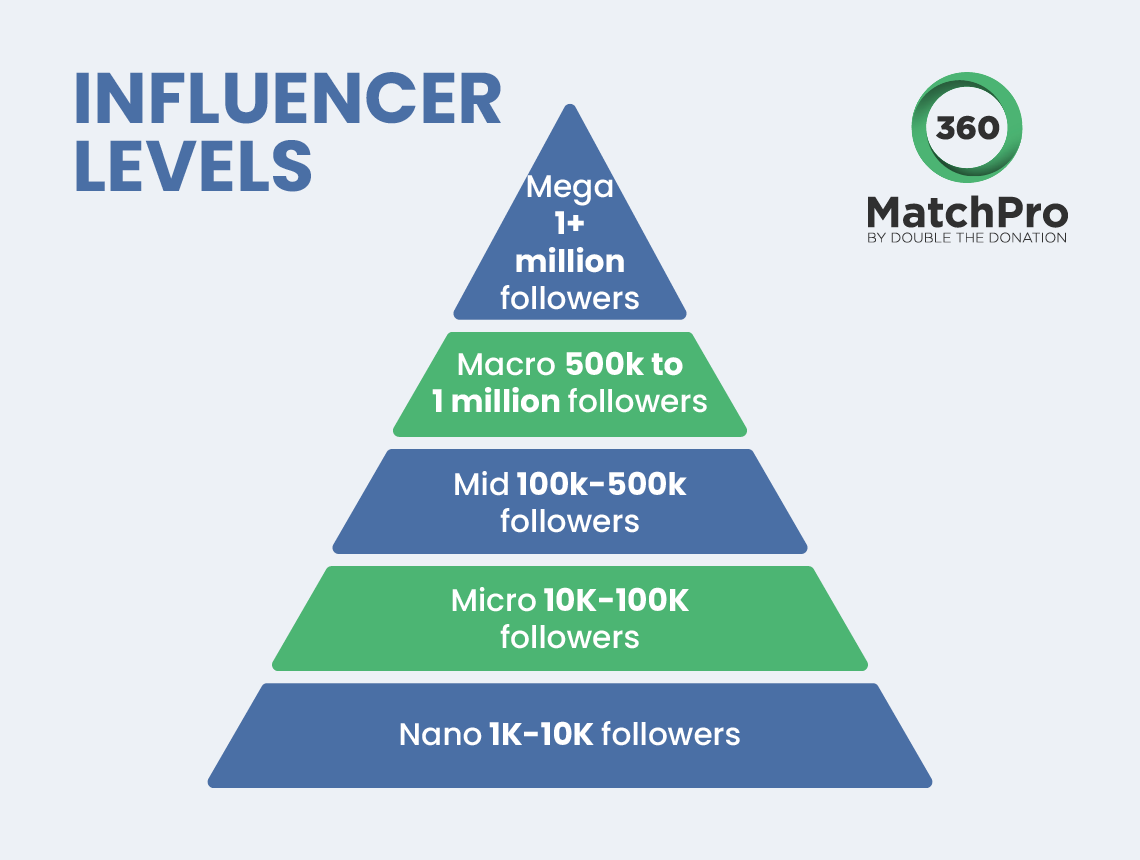
The second factor is the quality of the influencer’s audience. In most cases, an influencer whose content is related to your nonprofit’s mission is likely a better fit for your nonprofit than a larger influencer whose content is completely unrelated.
7. Events
Events are an opportunity for supporters to have some fun, learn about your mission, and support your cause through donations, ticket sales, or at-event purchases. Shore up support in your local community with an in-person event, or connect with supporters across the globe with a virtual or hybrid get-together.
A few ways you can maximize your events’ potential include:
- Host a variety of events throughout the year to engage your entire audience.
- Use event management software to track attendance.
- Have sales opportunities ready for products, branded merchandise, and concessions.
- Use gamification tools.
- Encourage supporters to take photos and videos to post online.
Events require marketing to succeed but are also a marketing tool in and of themselves. Consider hosting events to kick off or celebrate the end of other fundraisers to generate a swell of attention for those marketing efforts.
More Marketing Resources
Marketing campaigns drive attention to your nonprofit, helping you secure valuable donations, spread awareness, promote your services, attract customers, and more. To get started, consider your nonprofit’s goals, the resources currently at your disposal, and what messages are likely to resonate with your audience. From there, it’s time to start putting your marketing plan together!
Nonprofit marketing is an extensive topic, and if your nonprofit needs more information to launch your next marketing campaign, check out these resources:
- How to Market Matching Gifts: The Comprehensive FAQ Guide. Matching gifts are one of the easiest ways to increase your donation revenue. Check out how you can market this fundraiser to your audience.
- 15 Inspirational Cause Marketing Examples for Nonprofits. Cause marketing involves working with a company to market your nonprofit. Learn how to forge these partnerships to earn corporate support.
- Direct Marketing Fundraising: Talking to Donors One-on-One. Marketing to individual supporters can help you secure donations and forge lasting relationships. Discover how to engage in direct marketing fundraising.

